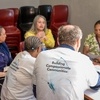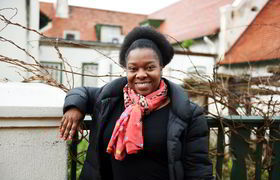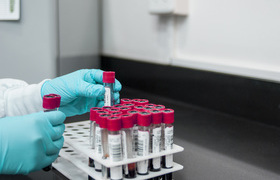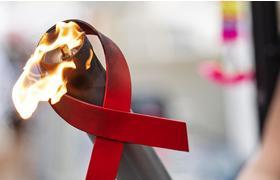Protecting young South African women from STIs
07 November 2018 | Story Kim Cloete. Photo Joshua Green. Read time 7 min.
The Desmond Tutu HIV Foundation at the University of Cape Town (UCT) is working on an encouraging new programme designed to help reduce the incidence of sexually transmitted infections (STIs), including HIV, among girls and young women.
The recently awarded grant, titled “A multilevel comprehensive HIV prevention package for South African adolescent girls and young women”, will focus on a sexual education and skills building programme that will improve support and communication between girls and young women and their mothers or other female caregivers.
Professor Linda-Gail Bekker, co-investigator on the study, explained that the Informed, Motivated, Aware and Responsible about AIDS (IMARA) programme, an evidence-based comprehensive HIV-prevention package designed by the University of Illinois at Chicago (UIC) in the United States, will be adapted for a South African context.
“We know it is really critical to empower young women to be able to protect themselves. There is also some evidence to show that family support is key, especially from an older female relative, such as a mother, an aunt or older sister,” she said.
“However often the adolescent doesn’t know how to reach out and the older relative also struggles to make contact on these issues. People need help in having these often tricky conversations.”
IMARA will explore this more deeply, and hopefully provide guidance, according to Bekker, who is also the chief operating officer of the Desmond Tutu HIV Foundation.
International project
The study is one of several international projects in Africa and Brazil that are part of the Prevention and Treatment through a Comprehensive Care Continuum for HIV-affected Adolescents in Resource Constrained Settings (PATC3H). The UIC received a two-year, $1.2 million grant from the National Institutes of Health (NIH) to tailor the programme in South Africa, while UCT is the implementing partner.
The IMARA programme includes education about STIs, including HIV, as well as communication skills that are designed to strengthen the mother/female caregiver–daughter bond. It also focuses on the importance of healthy peer and romantic relationships, effective parental monitoring and developing positive decision-making skills.
Professor Geri Donenberg, professor of Medicine and Psychology at UIC and principal investigator on the grant, said it is vital that this primary relationship in a young girl’s life remains strong and positive, with open lines of communication.
“Often the adolescent doesn’t know how to reach out and the older relative also struggles to make contact on these issues. People need help in having these often tricky conversations.”
“This has positive effects on the health of both of them, including, as we have shown, reducing the likelihood of acquiring a sexually transmitted infection,” she said.
The programme also encourages participants to consider how the media and its portrayal of young women influences their behaviour, and how those behaviours may affect health outcomes.
In a randomised controlled study in Chicago, IMARA reduced the risk of new STIs by 45% among black girls aged 14 to 18 years old, compared to the control group.
Apart from helping to prevent STIs, the programme is also designed to increase HIV testing and linkage to care at clinics among South African adolescent girls and their female caregivers.
Bekker explained that the grant will be conducted in two phases. Phase 1 will take the already developed IMARA programme and adapt it for the South African context in a pilot study involving 50 daughter–mother pairs.
“Recognising that context really matters, this is an important phase and will be done in partnership with communities linked to the Desmond Tutu HIV Foundation,” she said.
In the second phase they will randomise 525 daughter–mother/caregiver pairs to the now adapted IMARA programme.
“At the end of the study we will see whether we have made a difference in the STI rates among the girls and young women.”
Participants will be tested for HIV and other STIs at the beginning of the study, and at six and 12 months after enrolment. HIV counselling and testing and PrEP (pre-exposure prophylaxis) will be offered at each assessment. Participants interested in PrEP or who test positive for an STI, including HIV, will receive treatment at the Desmond Tutu HIV Foundation.
Tracking STIs
Bekker said STIs are an easier outcome to track than HIV. Although both result from unprotected sex, STIs occur more frequently than HIV.
According to the Joint United Nations Programme on HIV/AIDS, an estimated 1.6 million people aged 15 and older worldwide were newly infected with HIV in 2017. South Africa has the largest HIV epidemic in the world, and adolescent girls and young women acquire HIV at twice the rate of their male peers.
“We urgently need to find solutions for young women and adolescent girls in this region. Every week almost 2 000 young women and girls in South Africa get infected with HIV,” said Bekker.
She believes “we have always known that an answer to the HIV epidemic in young people lies in better relationships and communication between young women and their mothers and loved ones” – but haven’t known how to address this.
“This research may give us some very important answers. It seems very easy but in actual fact it is very tricky to do,” she added.
Donenberg said a focus on prevention is vital.
“As new infections continue to outpace access to and availability of drugs to prevent and treat HIV, primary prevention remains the most viable strategy to prevent new infections,” she said.
Bekker hopes the new study will offer important lessons on how to bring down the worrying rate of STIs among young women and girls.
“We hope to understand if this intervention is something that we can roll out more broadly to change the statistics of STI, unintended pregnancy and HIV in young women and girls,” she said.
 This work is licensed under a Creative Commons Attribution-NoDerivatives 4.0 International License.
This work is licensed under a Creative Commons Attribution-NoDerivatives 4.0 International License.
Please view the republishing articles page for more information.










